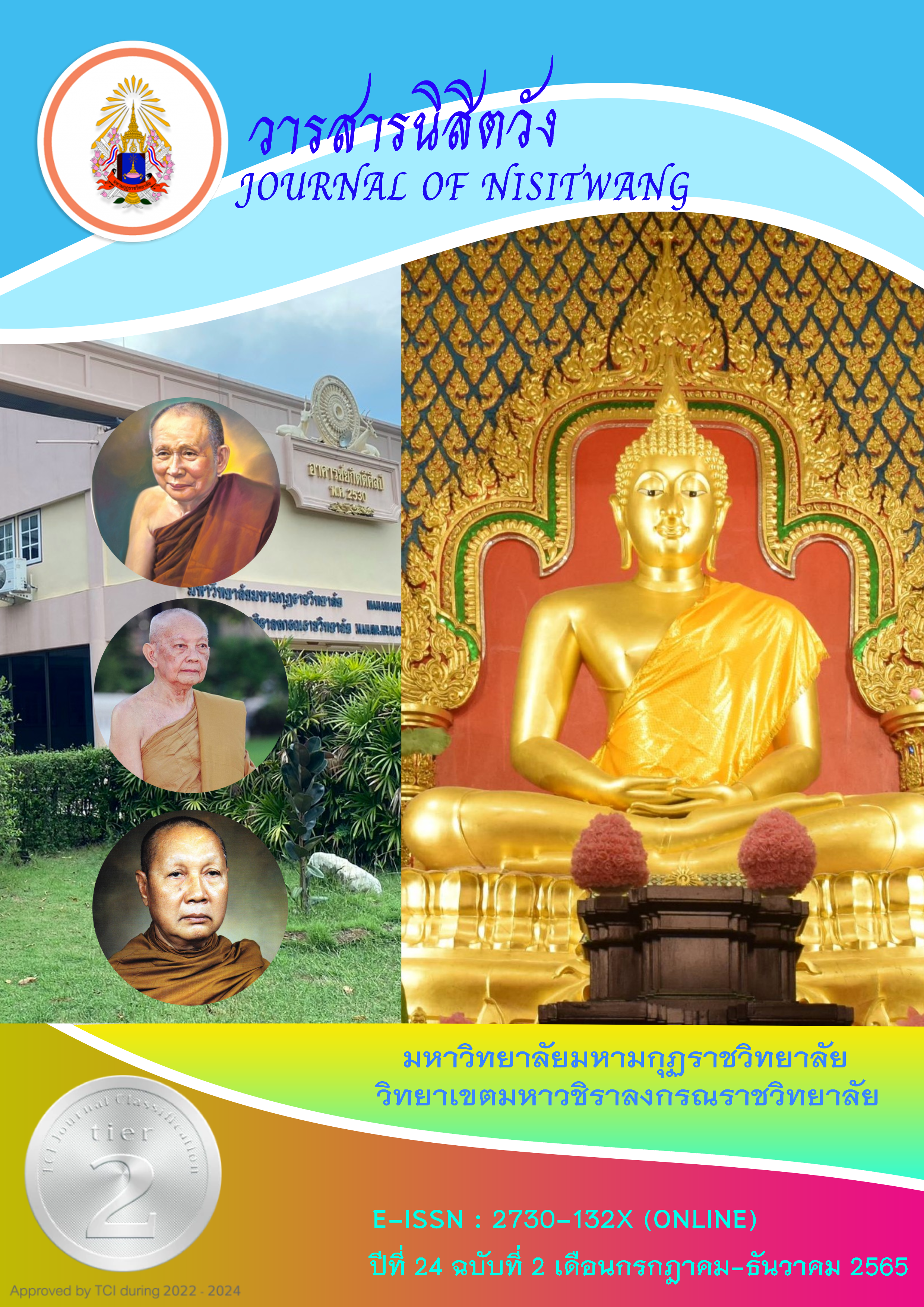THE EFFECT OF ACTIVE LEARNING ACTIVITIES USING BENCHAKIJ MODEL ON LEARNING ACHIEVEMENT, DIGITAL COMPETENCIES, AND LEARNING SATISFACTION OF PHYSICAL EDUCATION STUDENTS OF THAILAND NATIONAL SPORTS UNIVERSITY ANG THONG CAMPUS
Main Article Content
Abstract
The purpose of this research was to study the results of active learning activities using the Benchakij Model in the following areas : 1) to compare the learning achievement in the subjects of the students who were developed according to the learning activities with the set criterion of 70 percent 2) to compare the digital competencies of students who were developed according to the learning activities to the higher level criteria, and 3) to compared the learning satisfaction of students who were developed according to the learning activities to the higher-level criteria. The sample group consisted of 30 physical education students enrolled in the course of Educational Philosophy and Professional Teachers Characterization in the first semester of the academic year 2022, which were obtained by Cluster Random Sampling, using a classroom as a unit for randomization. The tools used were 1) the active learning activity plans using the Benchakij Model with average appropriateness of 4.82 2) the learning achievement test with the reliability value of 0.84 3) the digital competencies questionnaire with the reliability value of 0.89 and 4) the learning satisfaction questionnaire with the reliability value of 0.86. The statistics used in this study were Percentage, Mean, Standard Deviation, T-Test, and Content Analysis.
The results of this study were as follows :
1. The students who were developed according to the active learning activities using the Benchakij Model had learning achievement after the experiment higher than the set criterion of 70 percent with statistical significance at the .05 level.
2. The students who were developed according to the active learning activities using the Benchakij Model had a high level of digital competencies (x ̅=4.09, S.D.=0.62) which meets the criteria to a high level.
3. The students who were developed according to the active learning activities using the Benchakij Model had the highest level of learning satisfaction (x ̅=4.68, S.D.=0.40) which is higher than the criteria at a high level.
Article Details
References
กณิชชา ศิริศักดิ์. (2559). การวิจัยหลักสูตรวิชาชีพครูเพื่อพัฒนาแนวทางการส่งเสริมสมรรถนะดิจิทัล. วิทยานิพนธ์
ครุศาสตรมหาบัณฑิต จุฬาลงกรณ์มหาวิทยาลัย.
กรรณิการ์ ปัญญาดี. (2558). ผลการจัดกิจกรรมการเรียนรู้เชิงรุกออนไลน์เพื่อพัฒนาผลสัมฤทธิ์ทางการเรียนวิชา
คอมพิวเตอร์ 3 ของนักเรียนชั้นมัธยมศึกษาปีที่ 2. วิทยานิพนธ์ศึกษาศาสตรมหาบัณฑิต มหาวิทยาลัย
เทคโนโลยีราชมงคลธัญบุรี.
ชนิดา ทาระเนตร์. (2560). การพัฒนาผลสัมฤทธิ์ทางการเรียนคณิตศาสตร์เรื่องความน่าจะเป็นโดยการจัดการเรียน
การสอนเน้นกระบวนการกลุ่มสำหรับนักเรียนชั้นมัธยมศึกษาปีที่ 5 โรงเรียนสา จังหวัดน่าน. วิทยานิพนธ์
วิทยาศาสตรมหาบัณฑิต มหาวิทยาลัยบูรพา.
ชาญยุทธ ทองประพันธ์. (2562). การเปรียบเทียบผลสัมฤทธิ์ทางการเรียนระหว่างการเรียนด้วยชุดการสอนและวิธี
ปกติของนักเรียนระดับประกาศนียบัตรวิชาชีพ (ปวช.) ชั้นปีที่ 1 วิชางานฝึกฝีมือ 1. วิทยานิพนธ์ศึกษา
ศาสตรมหาบัณฑิต มหาวิทยาลัยหาดใหญ่.
ณัฐภณ หรรษกรคณโชค. (2564). การพัฒนาการสอนรายวิชาระบบปฏิบัติการด้วยวิธีการสอนแบบการจัดการเรียนรู้
เชิงรุก. พัฒนาเทคนิคศึกษา, 34 (120), 84-92.
ณัฐวดี ธาตุดี. (2561). การพัฒนาความสามารถด้านการอ่านอย่างมีวิจารณญาณของนักเรียนชั้นมัธยมศึกษาปีที่ 3
โดยการจัดกิจกรรมการเรียนรู้เชิงรุก (Active Learning). วิทยานิพนธ์ศึกษาศาสตรมหาบัณฑิต
มหาวิทยาลัยศิลปากร.
ทิศนา แขมมณี. (2554). ศาสตร์การสอน. พิมพ์ครั้งที่ 14. กรุงเทพฯ : จุฬาลงกรณ์มหาวิทยาลัย.
ธนวรรณ นัยเนตร และคณะ. (2560). ผลของการจัดการเรียนรู้เชิงรุกร่วมกับคำถามระดับสูงที่มีต่อความสามารถใน
การให้เหตุผลและผลสัมฤทธิ์ทางการเรียนคณิตศาสตร์ เรื่อง ฟังก์ชัน ของนักเรียนชั้นมัธยมศึกษาปีที่ 4.
วารสารวิชาการหลักสูตรและการสอน มหาวิ ทยาลัยราชภัฏสกลนคร. 9 (26), 77-90.
บุญชม ศรีสะอาด. (2560). การวิจัยเบื้องต้น. พิมพ์ครั้งที่ 10. กรุงเทพฯ : สุวีริยาสาส์น.
ประกาศคณะกรรมการคุรุสภา เรื่องหลักเกณฑ์และวิธีการทดสอบและประเมินสมรรถนะทางวิชาชีพครู ฉบับที่ 2
พ.ศ 2564 (2564, 18 พฤศจิกายน). ราชกิจจานุเบกษา. เล่ม 138 ตอนพิเศษ 283 ง. 19-22.
ประยูร บุญใช้. (2564). เบญจกิจโมเดล : รูปแบบการจัดการเรียนรู้เชิงรุกเพื่อพัฒนาผู้เรียนในศตวรรษที่ 21. วารสาร
หลักสูตรและการสอน มหาวิทยาลัยราชภัฏสกลนคร, 13 (38), 1-15.
ปราโมทย์ ถ่างกระโทก. (2563). การศึกษาองค์ประกอบสมรรถนะดิจิทัลของพยาบาลวิชาชีพไทย. วิทยานิพนธ์
พยาบาลศาสตรมหาบัณฑิต มหาวิทยาลัยสุโขทัยธรรมาธิราช.
รัศมี ศรีนนท์ และคณะ. (2561). การจัดการเรียนรู้เชิงรุกในยุคไทยแลนด์ 4.0. วารสารการบริหารการศึกษา
มหาวิทยาลัยศิลปากร, 9 (2), 331-343.
รุ่งภรณ์ กล้ายประยงค์. (2563). การจัดการเรียนรู้เชิงรุกในสาระการเรียนรู้การศึกษาค้นคว้าด้วยตนเอง. วารสาร
สถาบันวิจัยญาณสังวร, 11 (1), 104-113.
วราพร ดำจับ. (2562). สื่อสังคมออนไลน์กับการเรียนรู้ในศตวรรษที่ 21. วารสารศิลปศาสตร์มหาวิทยาลัยแม่โจ้. 7 (2), 143-159.
วิชัย วงษ์ใหญ่ และมารุต พัฒผล. (2564). สมรรถนะดิจิทัล. กรุงเทพฯ : มหาวิทยาลัยศรีนครินทรวิโรฒ.
สรัญญพัชร์ แก้วศรีไตร. (2563). การพัฒนาชุดกิจกรรมการเรียนรู้ภาษาไทยเพื่อการสื่อสาร เรื่องคำและหน้าที่ของ
คำโดยใช้การจัดการเรียนรู้เชิงรุกสำหรับนักเรียนชั้นประถมศึกษาปีที่ 6. วิทยานิพนธ์ครุศาสตรมหาบัณฑิต
มหาวิทยาลัยราชภัฏสกลนคร.
สำนักงานคณะกรรมการดิจิทัลเพื่อเศรษฐกิจและสังคมแห่งชาติ. (2562). กรอบสมรรถนะด้านดิจิทัลสำหรับพลเมืองไทย.
กรุงเทพฯ : มหาวิทยาลัยมหิดล.
Benjamin S. Bloom. (1956). Taxonomy of Educational Objectives, Handbook 1 : Cognitive Domain.
USA : Addison Wesley Publishing Company.
Elstad, E., and Christophersen, K. (2017). Perceptions of Digital Competency among Student
Teachers : Contributing to the Development of Student Teachers’ Instructional Self-Efficacy
in Technology-Rich Classrooms. Education Science, 7 (27), 1-15.
Hyun, J., et al. (2017). Students’ Satisfaction on Their Learning Process in Active Learning and
Traditional Classrooms. International Journal of Teaching and Learning in Higher
Education, 29 (1), 108-118.
Kovacevic, I., et al. (2021). Recognizing Predictors of Students' Emergency Remote Online Learning
Satisfaction during COVID-19. Education Sciences, 11 (693), 1-16.
Ozer, S. (2020). The Effect of Active Learning on Achievement and Attitude in Vocational English
Course. Inquiry in Education, 12 (2), 1-18.
Rintala, H., et al. (2019). The Concept of Active Learning and the Measurement of Learning
Outcomes : A Review of Research in Engineering Higher Education. Education Sciences,
(276), 1-19.
Suwanroj, T., et al. (2019). Confirmatory Factor Analysis of the Essential DigitalCompetencies for
Undergraduate Students in Thai Higher Education Institutions. Journal of Technology and
Science Education, 9 (3), 340-356.
Tsarapkina, J., et al. (2021). The Formation of Bachelors' Digital Competencies at the University.
Journal of Educational Psychology, 9(1), 1-10.

